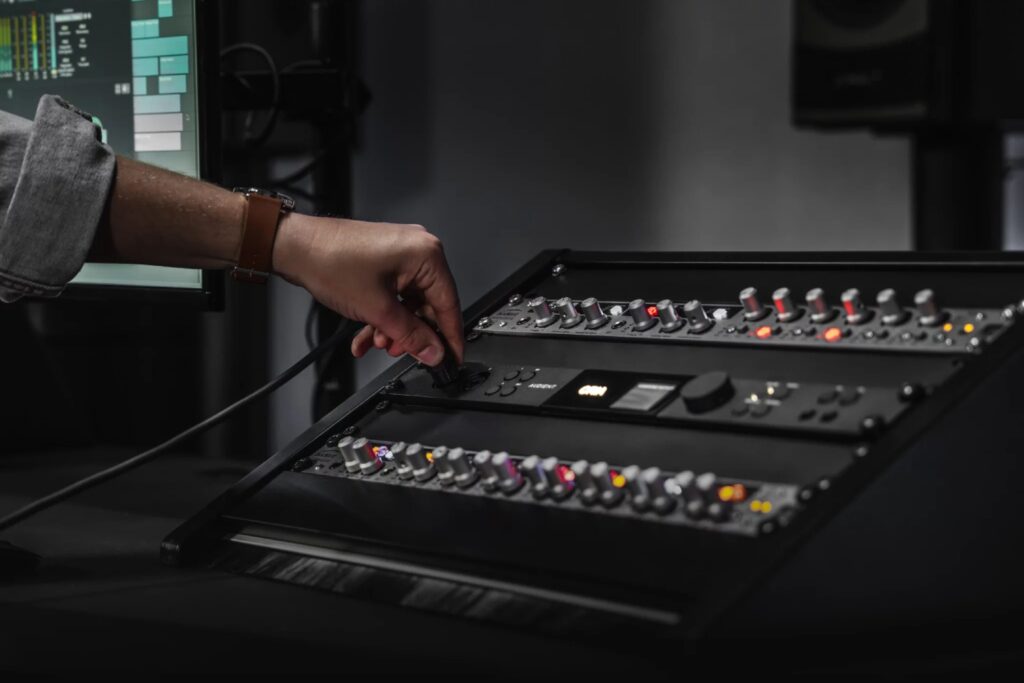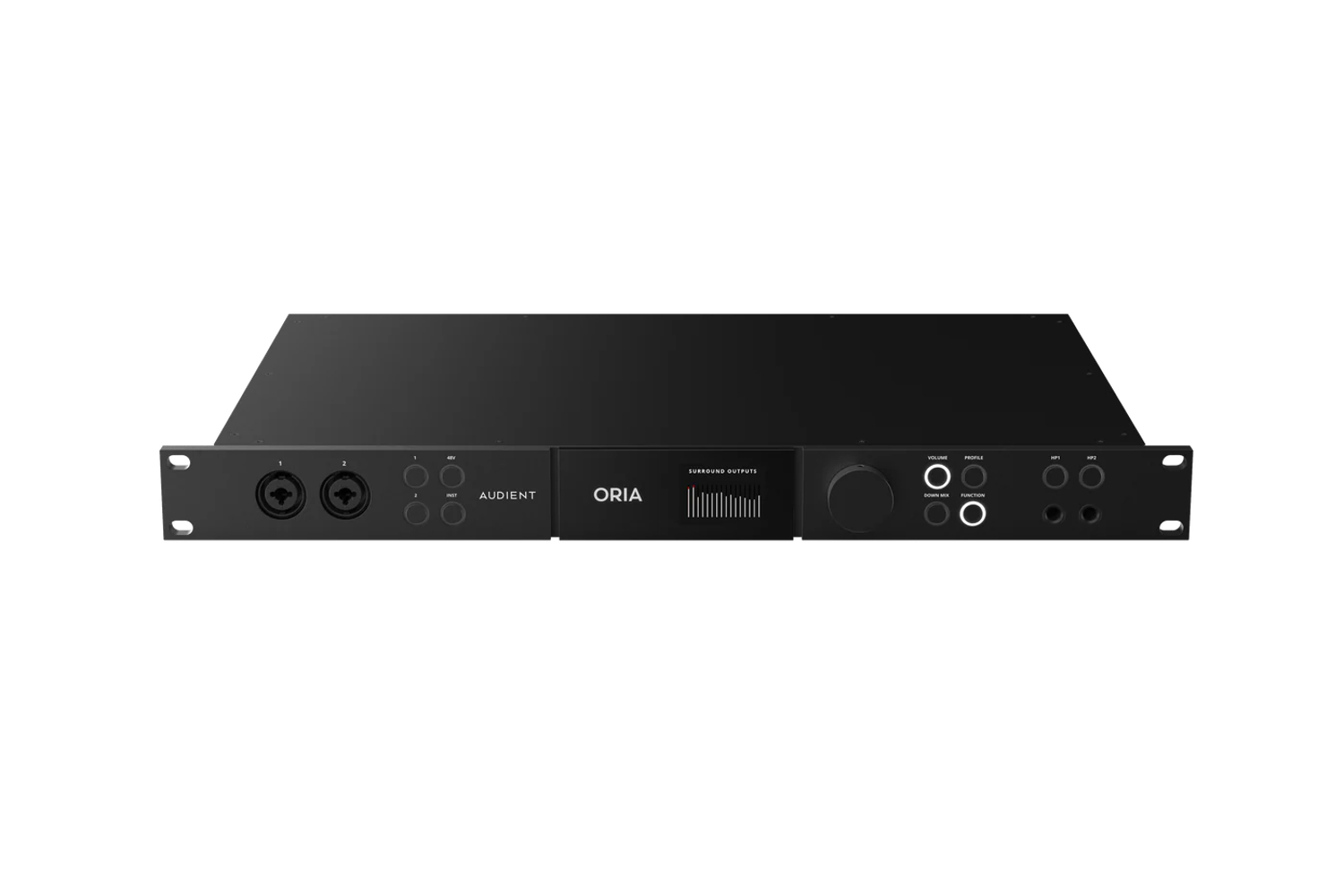Audient ORIA Immersive Interface and Monitor Controller | Studio Connections | RRP $4175
The foray into immersive audio can be a daunting and expensive undertaking, the most popular format being Dolby Atmos. While Atmos is technically headphone compatible, the real benefit and immersion is said to be best achieved with at least a 7.1.4 system, i.e. 7 floor channels (front, back and side speakers) and 4 height channels (i.e. ceiling speakers) along with a subwoofer/LFE (low-frequency effects channel). From the sheer number of monitors required to the logistics of bass management and monitor control, the setup can be quite complicated to get started. Audient’s new contender to wrangle this conundrum is the Audient ORIA Immersive Interface and Monitor Controller, a 16 speaker output USB audio interface specifically designed to simplify and address issues that come with such a high channel count of monitor speakers.
Read more gear reviews here.
Until now, early adopters of Atmos will have encountered a hurdle in the need for something as simple as changing the volume of 12+ channels of studio monitors uniformly and simultaneously. The most accessible and inexpensive version is to use a hi-fi receiver, however this option leaves the user stuck with unbalanced -10dB line-level making it a hassle to interface with +4dB line level balanced studio monitors, while the professional studio options jump quite considerably in price. The ORIA is a very welcome addition to the landscape, as it not only provides the option of a fully optimised monitor controller, but can also act as the audio interface completely, and has the added bonus of built in equalisation, time delay and bass management for each individual channel.
Audient ORIA
The unit also features two onboard mic pres on the front of the unit, which can double as high impedance instrument inputs. If more inputs are needed there is the possibility of a further 16 inputs via ADAT, as well as an optional Dante port for even more input options. Connection to studio monitors is via TRS 6.5mm sockets on the back of the unit, of which there are 16 for full surround sound duties, plus two additional stereo pairs for alternative L/R monitoring. Furthermore, the ORIA features 16 channels of AES outputs via DB-25, perfect for plugging straight into studio monitors that feature a digital input, negating an unnecessary digital to analogue and analogue to digital round of conversion. Rounding out the I/O are two headphone ports on the front (which can each each be routed to their own discrete inputs) word clock input and output, and of course the USB-C port for connecting to a computer (which can be used as a USB-A 2.0 device) on the rear.
Pulling the unit out of the box reveals a smart, sleek unit with backlit buttons and a nice multi-display, which won’t look out of place in any rack of gear. The unit cheerily displays “Dolby Atmos” upon startup, and then defaults to show the monitor outputs for the surround channels.
Getting started was very simple, fortunately for Mac users setup was a matter of plugging in the ORIA and loading up my selected DAW, while Windows users will need to install a driver before getting started. Having said that, it is recommended all users install the Monitor Controller software to reap the full benefits of the system, and the real engine of the ORIA’s options for EQ, bass management and channel delay.
Upon loading up I was advised by the software to update the firmware on the device, and this was as simple as hitting the ‘OK’ button and waiting a few minutes while the update was delivered. Once that was completed I restarted the unit and we were in business!
The ORIA software gives a clear and easy overview of the studio layout, as well as easy options for different room profiles and metering, with the floating meter window option being very convenient. In the Setup page, clicking on any of the speaker icons in the “Room” screen gives the user the option to apply up to 8 parametric bands of eq plus a high and low shelf, as well as crossover point and time delay. With such a number of monitors around the listener, these options are hugely important in immersive audio, to ensure an equal distance and even panning is achievable as objects move around the listener. With the use of time alignment, one can push speakers “further away” by delaying certain channels that might otherwise be too close in a room not be perfectly shaped for Atmos’ regulations. Audient have made what can be a complicated and confusing setup quite compact and simple in the layout of this software.
Other great software features are the inclusion of solo buttons for different groups of monitors, which is great for quickly checking what the overhead or LFE/sub channels are doing on their own, pre or post EQ metering, monitor DIM and phase flip buttons.

Sonarworks Monitor EQ software
Also included is a measurement microphone, which should be used to measure each individual channel’s frequency and time alignment to achieve maximum accuracy and optimised monitor placement, plus if the user wished to take things further there is a discount provided for the even more customisable Sonarworks Monitor EQ software.
The Audient ORIA has really filled a hole in the dilemma of immersive audio setup, and with this box Audient have provided both a starting from scratch audio interface, to a monitor controller that can fit with many pre-existing studio setups. With the inclusion of individual EQ, time alignment and bass management, the ORIA is a great option for taming the Atmos beast.
For local enquiries, visit Studio Connections.

